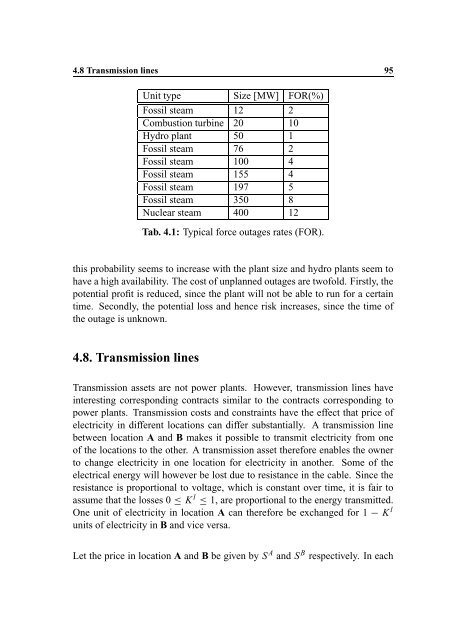Hedging Strategy and Electricity Contract Engineering - IFOR
Hedging Strategy and Electricity Contract Engineering - IFOR
Hedging Strategy and Electricity Contract Engineering - IFOR
Create successful ePaper yourself
Turn your PDF publications into a flip-book with our unique Google optimized e-Paper software.
4.8 Transmission lines 95<br />
Unit type Size [MW] FOR(%)<br />
Fossil steam 12 2<br />
Combustion turbine 20 10<br />
Hydro plant 50 1<br />
Fossil steam 76 2<br />
Fossil steam 100 4<br />
Fossil steam 155 4<br />
Fossil steam 197 5<br />
Fossil steam 350 8<br />
Nuclear steam 400 12<br />
Tab. 4.1: Typical force outages rates (FOR).<br />
this probability seems to increase with the plant size <strong>and</strong> hydro plants seem to<br />
have a high availability. The cost of unplanned outages are twofold. Firstly, the<br />
potential profit is reduced, since the plant will not be able to run for a certain<br />
time. Secondly, the potential loss <strong>and</strong> hence risk increases, since the time of<br />
the outage is unknown.<br />
4.8. Transmission lines<br />
Transmission assets are not power plants. However, transmission lines have<br />
interesting corresponding contracts similar to the contracts corresponding to<br />
power plants. Transmission costs <strong>and</strong> constraints have the effect that price of<br />
electricity in different locations can differ substantially. A transmission line<br />
between location A <strong>and</strong> B makes it possible to transmit electricity from one<br />
of the locations to the other. A transmission asset therefore enables the owner<br />
to change electricity in one location for electricity in another. Some of the<br />
electrical energy will however be lost due to resistance in the cable. Since the<br />
resistance is proportional to voltage, which is constant over time, it is fair to<br />
assume that the losses 0 K l 1, are proportional to the energy transmitted.<br />
One unit of electricity in location A can therefore be exchanged for 1 K l<br />
units of electricity in B <strong>and</strong> vice versa.<br />
Let the price in location A <strong>and</strong> B be given by S A <strong>and</strong> S B respectively. In each
















